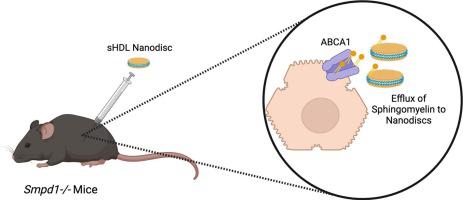Nanomedicine: Nanotechnology, Biology and Medicine ( IF 5.4 ) Pub Date : 2023-08-24 , DOI: 10.1016/j.nano.2023.102705 Troy A Halseth 1 , Adele B Correia 2 , Mark L Schultz 3 , Maria V Fawaz 1 , Esmée Q Kuiper 2 , Preethi Kumaran 4 , Kristen Hong Dorsey 4 , Edward H Schuchman 5 , Andrew P Lieberman 2 , Anna Schwendeman 6

|
Acid sphingomyelinase deficiency (ASMD) is a severe lipid storage disorder caused by the diminished activity of the acid sphingomyelinase enzyme. ASMD is characterized by the accumulation of sphingomyelin in late endosomes and lysosomes leading to progressive neurological dysfunction and hepatosplenomegaly. Our objective was to investigate the utility of synthetic apolipoprotein A-I (ApoA-I) mimetics designed to act as lipid scavengers for the treatment of ASMD. We determined the lead peptide, 22A, could reduce sphingomyelin accumulation in ASMD patient skin fibroblasts in a dose dependent manner. Intraperitoneal administration of 22A formulated as a synthetic high-density lipoprotein (sHDL) nanodisc mobilized sphingomyelin from peripheral tissues into circulation and improved liver function in a mouse model of ASMD. Together, our data demonstrates that apolipoprotein mimetics could serve as a novel therapeutic strategy for modulating the pathology observed in ASMD.
中文翻译:

载脂蛋白模拟纳米盘可减少酸性鞘磷脂酶缺乏症患者的脂质积累并改善肝功能
酸性鞘磷脂酶缺乏症(ASMD)是一种由酸性鞘磷脂酶活性降低引起的严重脂质储存障碍。ASMD 的特点是鞘磷脂在晚期内体和溶酶体中积聚,导致进行性神经功能障碍和肝脾肿大。我们的目的是研究合成载脂蛋白 AI (ApoA-I) 模拟物的效用,该模拟物旨在作为脂质清除剂治疗 ASMD。我们确定先导肽 22A 可以以剂量依赖性方式减少 ASMD 患者皮肤成纤维细胞中鞘磷脂的积累。在 ASMD 小鼠模型中,腹腔内施用合成高密度脂蛋白 (sHDL) 纳米盘形式的 22A 可将周围组织中的鞘磷脂调动到循环中,并改善 ASMD 小鼠的肝功能。总之,我们的数据表明载脂蛋白模拟物可以作为调节 ASMD 病理学的新型治疗策略。



























 京公网安备 11010802027423号
京公网安备 11010802027423号